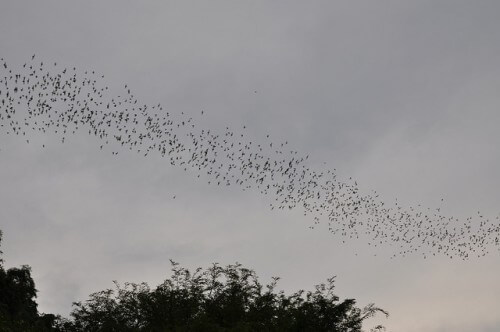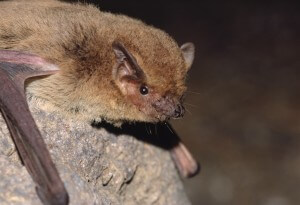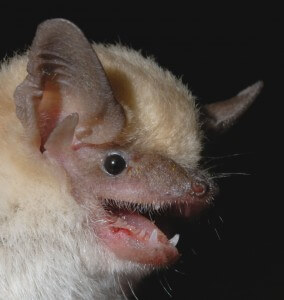
Most of us have negative memories of encounters with insects. Whether due to an unpleasant mosquito, wasp or bee sting, or a moth discovered in the wardrobe - most of us hate these pests and prefer to avoid them as much as possible. In contrast to us, there are those in the living world who actually love them very much - these are the insect bats.
If you look closely at a bat that feeds on insects, you will find it hard to believe how these small creatures, most of which weigh no more than a few grams, are able to devour huge amounts of insects. Studies have found that in one night, an insect bat from a species Myotis lucifugusEats more than half of his body weight. Moreover: many studies point to the role of insect bats as natural pest exterminators in a variety of agricultural and natural environments, and according to New studies, their economic contribution to pest control in corn fields in the world is over a billion dollars.
Israel was blessed with a rich variety of these "natural exterminators". as per The Red Book of Vertebrates in Israel, in Eretz Haim there are 32 species of insect bats. However, in view of the multitude of anthropogenic disturbances - disturbances created as a result of human activity - such as reduction and loss of habitats, pests, damage to water sources and disturbance of travelers who come to visit the caves, today most of the insect bat species in Israel (29 out of 32 species) are in danger of extinction.
A lesser known human disturbance, which also affects bats, among others, is the negative effect of artificial night lighting, known as "light pollution". for light pollution A variety of negative consequences, the main ones of which concern the disruption of biological clocks, the animal's absolute attraction or repulsion to a blinding light source (such as the attraction of insects to a street lamp) and the increase or decrease of the animal's ability to orientate in space.
בstudy Conducted by Dr. Tal Pollak, Prof. Karmi Korin and their colleagues at the Desert Research Institutes at Ben Gurion University of the Negev, the effect of artificial night lighting on the activity of two species of insect bats was examined: the white-margined bat and the Negev dusky bat. The results of the study reveal that the Negev dimple has difficulty adapting to the new lighting conditions. The insects that are food for that bat may also be affected by this.
Less bats, more insects
In the study, the flight behavior of both sexes was examined in light and dark conditions. The researchers found that artificial lighting had an effect on both species, and they changed their flight speed and tended to fly faster under lighting conditions.
In addition to the change in flight speed, it was found that the desert species (the Negev twilight) reduced its activity and did not even fly for food in areas that were illuminated. According to the researchers, these findings raise concerns about the preservation of the desert species: it seems that, unlike the white shrike, which is able to adapt to the lighting conditions, the Negev skunk is damaged by the lighting and is unable to adapt to it. Therefore, it is possible that the expansion of settlements, roads and infrastructures that are lit at night will lead to the reduction of the habitat areas of the Negev night owl on the one hand and other desert species, and will encourage the invasion of the white-tailed deer on the other hand.
Why should these findings concern us? After all, many of us are afraid of bats and would even be happy to avoid meeting them in any way. However, according to Prof. Korin, it is possible that the change of the habitat as a result of the lighting will lead to the worsening of the competition between different species of bats in favor of species that are able to adapt to these conditions, such as the marginal bat. The worsening of competition in favor of adaptive species may also lead to an imbalance among the societies of insects and arthropods that feed on the same bats - because different species of bats do not necessarily feed on the same insects. It is possible that in illuminated areas we will see, over time, an increase in the amount of certain nocturnal insects that were previously hunted by desert species that are rejected by illumination, such as the darkness of the Negev.
Dr. Assaf Tzoer, an ecologist for the Southern District of the Nature and Parks Authority, qualifies things a bit, but emphasizes that "we don't know how serious this competition is between the species, but we know that artificial light causes a behavioral change among bat species, such as rejection of Several desert species from illuminated areas. This may also have indirect effects." In general, bats and the white fringed telephone in particular can be seen as a bio-indicator (biological marker) of human disturbances to nature, therefore the spread of its population suggests to us the existence of a disturbance.
How to keep the darkness?
According to Prof. Korin, although there are currently no proactive actions being taken to preserve the Negev's dusky, there is a national monitoring program that aims to provide long-term estimates about the diversity and abundance of the populations of the bat species, and this will also have consequences for actions in the field. Dr. Assaf Tzoer adds that "currently, actions are being taken, directly and indirectly, which in one way or another preserve the species of bats in Israel". For example, in the nature reserves water drainage systems are maintained, in agricultural fields the use of pesticides is minimized and in the north of the country they even close caves to public activity during sensitive periods.
In the field of light pollution, the Nature and Parks Authority creates collaborations with planning and development entities such as "Mekorot" and promotes policy documents and guidelines for lighting planning, with the aim of reducing the ecological damage created by artificial lighting in lighted facilities. Committee of experts which is meeting this week under the auspices of the Israeli Association for Ecology and Environmental Sciences will try to formulate additional measures to address the issue of light pollution, both in the natural environment and in the human environment.
More of the topic in Hayadan:


